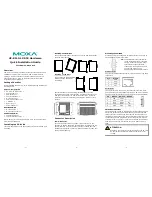
hand.
All covers and safety devices must be properly
fitted before the equipment is switched on.
Before switching on, make sure that everything
has been properly assembled and that moving
parts can move easily.
5.2 Electrical connection
Before you connect the equipment to the mains
supply make sure that the data on the rating plate
are identical to the mains data.
Always pull the power plug before making
adjustments to the equipment.
The equipment may only be operated with single-
phase current 230 Volt / 50 Hz. The electric circuit
of the house must be protected by no more than a
16A fuse.
5.3 General instructions for the equipment
The leadscrew (13) is allowed to be used only for
thread turning. It must not be used for automatic
longitudinal turning work because the feed will not
cut out if it strikes an obstacle.
Important.
Close the safety guard for the jaw
chuck before switching the equipment on.
5.4 Fitting / Replacing the clamp jaws
(Fig. 3-9/Item 26)
The clamp jaws (26) are marked with numbers 1 to 3
and must be fitted into the clamp jaw guide (A) in the
three-jaw chuck (27) in the right order.
First fit the jaw chuck wrench (41) into one of the
clamp screws on the three-jaw chuck (28) and
undo the clamp jaws (26) by turning the jaw
chuck wrench (41) anti-clockwise until you can
remove the clamp jaws (26) (Fig. 3).
Select the clamp jaws you wish to fit (see point
5.5) and sort them by their numbers (there is a
number code on each of the clamp jaws, starting
with a 1, 2 or 3) (Fig. 4-6).
Guide clamp jaw number 1 into one of the clamp
jaw guides (A) and push it towards the center of
the three-jaw chuck (27).
Now turn the jaw chuck wrench (41) anti-
clockwise until clamp jaw number 1 slips slightly
towards the center of the three-jaw chuck (27)
(Fig. 7).
Now fit clamp jaws number 2 and 3 in order
clockwise into the other two clamp jaw guides
(A).
Push all three clamp jaws (26) together and pull
the three-jaw chuck (27) together by turning the
jaw chuck wrench (41) clockwise. Inside the
three-jaw chuck (27) there is a thread that
engages in the notches on the reverse of the
clamp jaws (26) and thus pulls them together
(Fig. 8).
Check that the clamp jaws (26) clamp in the
center by turning the clamp jaws (26) fully
together using the clamp jaw wrench (41). If the
clamp jaws (26) are not all in the center, they
must be removed and then fitted again (Fig. 9)
5.5 Externally and internally stepped clamp jaws
(Fig. 4 – 6/Item 26)
Workpieces with a diameter of up to approx. 70 mm
are clamped by their external diameter (Fig. 6).
Workpieces with an external diameter of 1.5 to 30 mm
can be clamped using externally stepped clamp jaws
(a) (Fig. 5a).
Workpieces with a bore hole of at least 25 mm can be
clamped by the bore hole using the externally
stepped clamp jaws (a) (Fig. 5b). By replacing the
externally stepped clamp jaws (a) with the internally
stepped clamp jaws (b) it is possible to clamp
workpieces with a diameter of up to 70 mm.
Important:
Workpieces must be clamped a sufficient distance
into the three-jaw chuck (27).
Remove the jaw chuck wrench (41). Make sure that
the workpiece is clamped securely.
5.6 Clamping the turning tool (Fig. 10 – 11)
The turning tool (B) must be clamped in the tool
holder (23) using at least two clamp screws (25).
Clamp the turning tool (B) with as short a length as
possible so as to achieve as short a lever distance
(D) as possible and check that the setting height is
correct. The height of the turning tool (B) can be
adjusted by inserting flat plates (C) of differing
thicknesses. Check the height of the turning tool
against the center of the workpiece using the
centering tip (21) on the tailstock (17). The tool holder
(23) can be swung and adjusted to a different working
position by undoing the clamp lever (24).
This allows up to four turning tools (B) to remain
clamped in the tool holder (23) and you can switch
between them by swinging the tool holder (23).
Important:
The turning tool (B) must be clamped so that its axis
is perpendicular to the workpiece axis.
If it is clamped at a different angle, the turning tool (B)
may be drawn into the workpiece.
GB
19
Anleitung_BT_ML_300_SPK1:_ 22.12.2008 14:45 Uhr Seite 19
















































